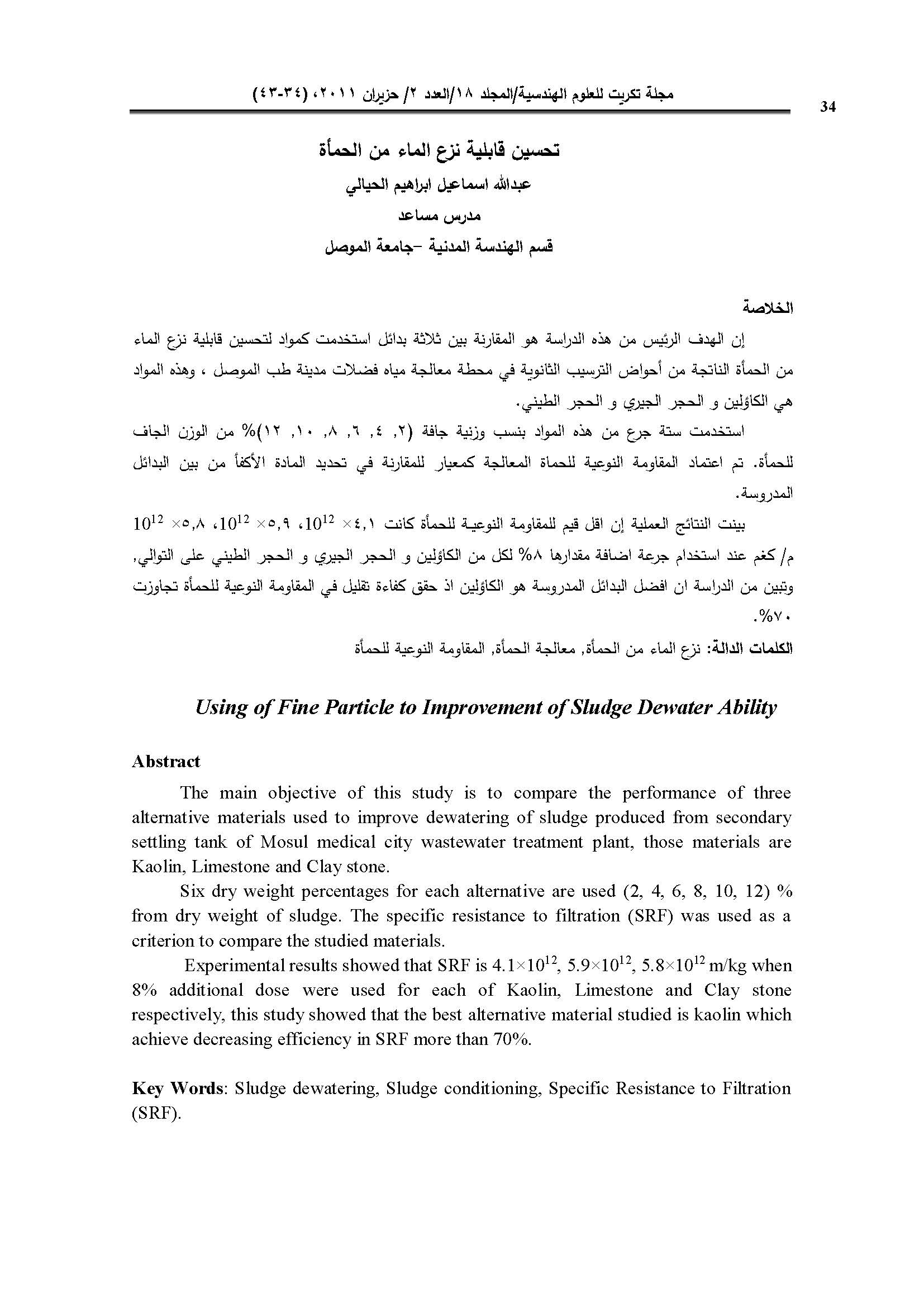Using of Fine Particle to Improvement of Sludge Dewater Ability
Main Article Content
Abstract
The main objective of this study is to compare the performance of three alternative materials used to improve dewatering of sludge produced from secondary settling tank of Mosul medical city wastewater treatment plant; those materials are Kaolin, Limestone and Clay stone.
Six dry weight percentages for each alternative are used (2, 4, 6, 8, 10, 12) % from dry weight of sludge. The specific resistance to filtration (SRF) was used as a criterion to compare the studied materials.
Experimental results showed that SRF is 4.1×1012, 5.9×1012, 5.8×1012 m/kg when 8% additional dose were used for each of Kaolin, Limestone and Clay stone respectively, this study showed that the best alternative material studied is kaolin which achieve decreasing efficiency in SRF more than 70%.
Metrics
Article Details

This work is licensed under a Creative Commons Attribution 4.0 International License.
THIS IS AN OPEN ACCESS ARTICLE UNDER THE CC BY LICENSE http://creativecommons.org/licenses/by/4.0/
Plaudit
References
Steel, E.W. and McGhee, T.J., (1990), “Water supply and sewerage”5th McGraw-Hill.
Liu, Sean X., (2007), “Food and agricultural wastewater utilization and treatment” Black Well Publishing. DOI: https://doi.org/10.1002/9780470277683
Wiener, Ruth F. and Matthews, Robin, (2003), “Environmental Engineering”, 4th Butterworth Heinemann.
Berktay, Ali, (1998), “Properties of sludge produced from the pressurized wastewater treatment process”, Tr. J. of Engineering and Environmental Science, 22, pp.377- 385.
Ghebremichael, Kebreab A. and Hultman, Bengt, (2004), “Alum sludge dewatering using moringa oleifera as a conditioner”, J. Water, Air, and Soil Pollution, vol. 158, pp. 153-167. DOI: https://doi.org/10.1023/B:WATE.0000044852.23764.9c
Eckenfelder, W. Wesley Jr., (2000), “Industrial water pollution control” 3rd Ed. McGRAW-HILL International Editions. DOI: https://doi.org/10.1002/0471238961.1615121205031105.a01
Katja, Haarainen and Mika, Sillanpaa (2007), “Flocculation in paper and pulp millsludge process”, Res. J. Chem. Environ., vol. 11 (3) Sep, pp.96-103
Buyukkamaci, N. and Kucukselek E, (2006), “Improvement of dewatering capacity of a petrochemical sludge”, Elsevier B.V. pp. 323-327. DOI: https://doi.org/10.1016/j.jhazmat.2006.10.034
Chia-Hung, Hou and Kung-Cheh, Li ,(2003), “Assessment of sludge dewaterability using rheological properties” , Journal of the Chinese Institute of Engineers, Vol. 26, No. 2, pp. 221-226 DOI: https://doi.org/10.1080/02533839.2003.9670772
Sommerfeld, D. and Maxham, J.V., (1983), “The effect of fine particle addition on the dewatering characteristics”, A progress report to members of the institute of paper chemistry, Appleton, Wisconsin, pp. 1-16.
Pansu, Marc and Gautheyrou, Jacques, (2006), “Handbook of soil analysis, mineralogical, organic and inorganic methods”, Springer-Verlag Berlin Heidelberg. DOI: https://doi.org/10.1007/978-3-540-31211-6
Attar, M. H. ,Bina, B. and Moeinian, Kh, (2005), “Effects of aeration rate and detention time on thermophilic
Aerobic digestion of mixed sludge and its dewaterability”, International journal of Environmental Science and Technology, Vol. 2, No. 2, pp. 105-111.
Murthy, Sudhir N., (1998),” Bioflocculation: implications for activated sludge properties and wastewater treatment”, Ph.D. thesis, Virginia Polytechnic Institute and State University.
Metcalf and Eddy, (2003), “Wastewater engineering treatment and reuse”, McGraw- Hill companies Inc.4th Edition.





